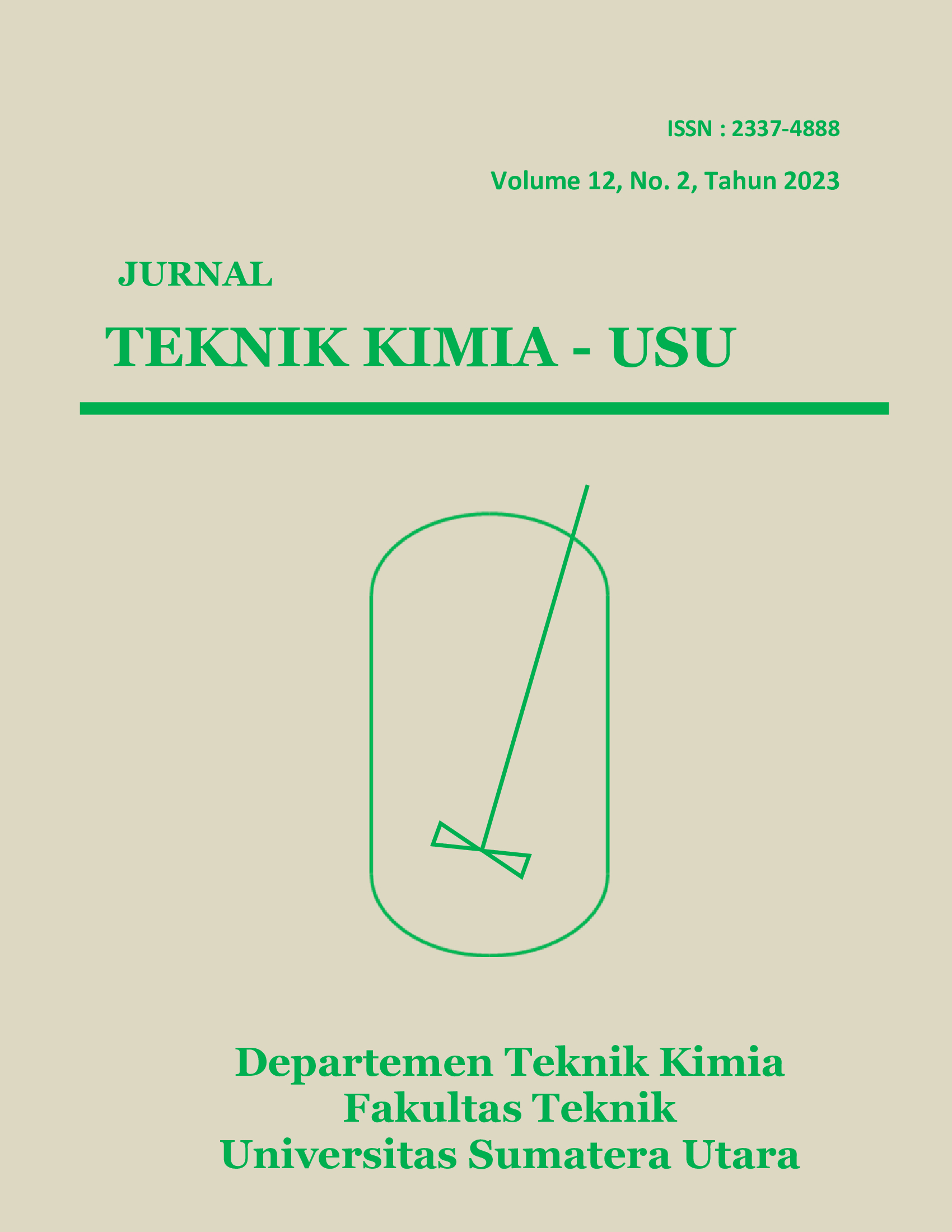Penggunaan Adsorben Bentonit pada Proses Pencucian Kering dalam Pemurnian Biodiesel Minyak Jelantah
DOI:
https://doi.org/10.32734/jtk.v12i2.11644Keywords:
biodiesel, cooking oil, bentonite, dry washing, adsorbentAbstract
Biodiesel can be made by utilizing used cooking oil through a chemical process, namely through a transesterification reaction, namely changing the oil (triglycerides) into fatty acid methyl esters. Washing must be done to remove the remaining impurities in biodiesel. The dry washing method is purification by utilizing the adsorption process to remove impurities in crude biodiesel. Bentonite is an alternative adsorbent that can be used as dry washing in the biodiesel refining process because it is cheaper, abundant in nature and has a layered structure with the ability to swell. The purpose of the study was to determine the ability of bentonite activated with acid as a dry washing agent in biodiesel purification. The research method used is the dry washing process method using bentonite adsorbents. The application of bentonite adsorbent as much as 6 grams with a contact time of 3 hours is the best operating condition to produce biodiesel with a pH of 6 and a clarity value of 96.7.
Downloads
References
F. I. Darmawan, I. W. Susila, “Proses produksi biodiesel dari minyak jelantah dengan metode pencucian dry-wash sistem,†Jtm, vol. 01, no. 01, pp. 80–87, 2013.
S. Widyanagari, “Penggunaan adsorben dalam proses pemurnian biodiesel jarak pagar (Jatropha curcas Linn)â€, Skripsi, Fakultas Teknologi Pertanian Universitas Pertanian Bogor, 2008.
F. D. Nurdyaningrum dan H. Nasrudin, “Pemurnian dan karakterisasi biodiesel dari minyak biji kelor (Moringa oleifera) dengan menggunakan adsorben bentonit,†UNESA J. Chem., vol. 2, no. 1, 2013.
I. Gupta, S. C. Muster, B. Klaus, and A. J. Jarvelin, “Alternative polyandenylation diversifies post-transcriptional regulation by selective RNA-protein interactionsâ€. Mol Syst Biol 10, 719, 2014.
A. S. Maylani, T. Sulistyaningsih, and E. Kusumastuti, “Preparasi nanopartikel Fe3O4 (magnetit) serta aplikasinya sebagai adsorben ion logam kadmium,†Indones. J. Chem. Sci., vol. 5, no. 2, pp. 130–135, 2016.
P. Suarya, “Adsorpsi pengotor minyak daun cengkeh oleh lempung teraktivasi asam,†J. Kim., vol. 2, no. 1, pp. 19–24, 2008.
S. Puspaningrum, “Pengaruh jenis adsorben pada pemurnian biodiesel dari minyak jarak pagar (Jatropa Curcas L.),†Skripis. Fakultas Teknologi Pertanian Universitas Pertanian Bogor, 2007.
G. Mendow, N. S. Veizaga, B. S. Sánchez, and C. A. Querini, “Biodiesel production by two-stage transesterification with ethanol by washing with neutral water and water saturated with carbon dioxide,†Bioresour. Technol., vol. 118, pp. 598–602, 2012.
S. Baroutian, K. Shahbaz, F. S. Mjalli, I. M. Alnashef, and M. A. Hashim, “Adsorptive removal of residual catalyst from palm biodiesel: Application of response surface methodology,†Hemijska Industrija., vol. 66, no. 3, pp. 373–380, 2012.
L. H. Cheng, Y. F. Cheng, S. Y. Yen, and J. Chen, “Ultrafiltration of triglyceride from biodiesel using the phase diagram of oil–FAME–MeOH,†J. Memb. Sci., vol. 330, no. 1–2, pp. 156–165, 2009.
G. Q. Lu et al., “Inorganic membranes for hydrogen production and purification: A critical review and perspective,†J. Colloid Interface Sci., vol. 314, no. 2, pp. 589–603, Oct. 2007.
I. J. Stojkovic, O. S. Stamenkovic, D. S. Povrenovic, and V. B. Veljkovic, “Purification technologies for crude biodiesel obtained by alkali-catalyzed transesterification,†Renew. Sustain. Energy Rev., vol. 32, pp. 1–15, 2014.
M. Berrios, M. A. Martin, A. F. Chica, and A. Martin, “Purification of biodiesel from used cooking oils,†Appl. Energy, vol. 88, no. 11, pp. 3625–3631, 2011.
R. Alamsyah and E. H. Loebis, “Design and technical testing for crude biodiesel reactor using dry methods: Comparison of energy analysis,†Energy Procedia, vol. 47, pp. 235–241, 2014.
K. Suppalakpanya, S. B. Ratanawilai, and C. Tongurai, “Production of ethyl ester from esterified crude palm oil by microwave with dry washing by bleaching earth,†Appl. Energy, vol. 87, no. 7, pp. 2356–2359, 2010.
N. Suriaini, T. T. Febriana, A. Yulanda, A. Adisalamun, Y. Syamsuddin, and M. D. Supardan, “Purification of biodiesel from waste cooking oil using bentonite as dry washing agent,†J. Rekayasa Kim. Lingkung., vol. 14, no. 2, pp. 155–162, 2019.
T. Lathifah, N. Yuliani, and G. A. P. K. Wardhani, “Bentonit teraktivasi asam sulfat sebagai adsorben dalam pemurnian pelumas bekas,†J. Sains Nat., vol. 9, no. 1, p. 1, 2019.
N. Nuraeni, Y. F. Yun, and D. M. Agustini, “Biodiesel from waste cooking oil using activate carbon as adsorbent and synthesis of triaacetin using nitric acid as catalyst,†J. Kartika Kim., vol. 2, no. 1, pp. 17–22, 2019.
V. A. Umami, “Sintesis biodiesel dari minyak jelantah dengan gelombang mikro, Tugas Akhir, Fakultas Teknik Kimia Universitas Negeri Semarang, Semarang, 2015.
S. N. Indonesia and B. S. Nasional, “SNI 3506:2017,†2015.
G. Fikria and C. Rustana, “Analysis of the physical characteristics of biodiesel products made from used cooking oil,†J. Neutrino, vol. 14, no. 2, pp. 63–69, 2022.
F. Destri dan H. Nasrudin, “Pemurnian dan karakterisasi biodiesel dari minyak biji kelor (Moringa oleifera) dengan menggunakan adsorben bentonit,†UNESA J. Chem., vol. 2, no. 1, 2013.
Atikah, “Peningkatan mutu minyak goreng bekas dengan proses adsorpsi menggunakan Ca bentonit,†Distilasi, vol. 3, no. 2, pp. 22–32, 2018.
Downloads
Published
Issue
Section
License
Copyright (c) 2023 Jurnal Teknik Kimia USU

This work is licensed under a Creative Commons Attribution-ShareAlike 4.0 International License.

















